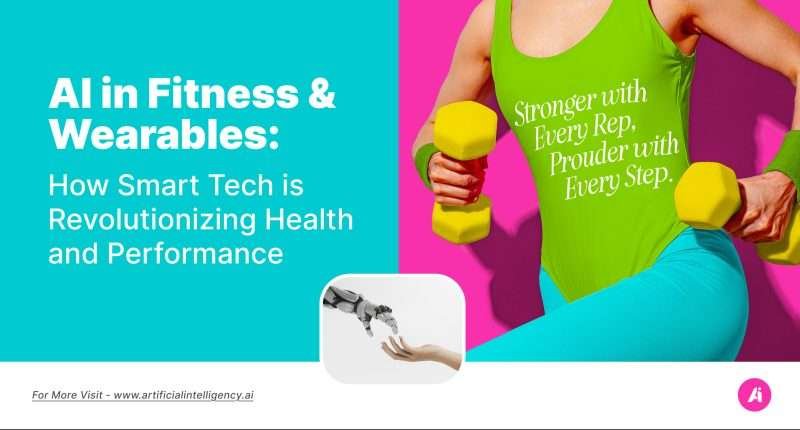The fitness and health industry is undergoing a massive transformation, driven by the integration of artificial intelligence (AI) into wearable technology. From fitness trackers and smartwatches to smart clothing and virtual reality headsets, AI is elevating how we understand and improve our bodies. What used to be generic data is now deeply personalized insight—driven by algorithms capable of learning from our behaviors, physiology, and progress.
AI doesn’t just track steps or heart rates anymore—it can anticipate injuries, optimize training loads, and even detect early signs of illness. As health and performance become more data-driven, consumers and professionals alike are turning to AI-powered tools to gain a competitive edge, improve overall wellness, and make smarter decisions based on real-time feedback.
AI-Based Wearable Market Overview
The AI-powered wearable market is experiencing exponential growth. According to market research, the global wearable AI market is projected to exceed USD 260.29 billion by 2032, driven by increasing consumer awareness and demand for health optimization. The intersection of AI and wearables is reshaping sectors like fitness, healthcare, and sports, as devices become smarter, smaller, and more affordable. Major tech companies like Apple, Google, and Samsung are investing heavily in AI-focused features that push their devices beyond traditional boundaries.
This growth isn’t limited to tech giants—startups and health-focused companies are also innovating rapidly. As sensor technology improves and machine learning models become more efficient, wearables are gaining the ability to track complex biometrics, provide actionable insights, and even interface with other smart health systems. The result is an ecosystem of interconnected tools that personalize care and performance in ways that were unthinkable a decade ago.
Key Examples of Wearable AI Devices
1. Fitness Trackers
Fitness trackers are perhaps the most widely recognized form of AI-infused wearables. Devices like Fitbit, Garmin, and WHOOP utilize AI algorithms to monitor a user’s daily activity, heart rate variability, sleep quality, and recovery patterns. These devices go beyond step counting, offering insights into calorie burn, stress levels, and cardiovascular health, allowing users to take a proactive approach to their wellness.
AI enhances these trackers by personalizing feedback and making suggestions in real-time. For example, WHOOP’s strain and recovery scores are derived from continuous monitoring and AI pattern recognition. This allows users to know not only how hard they should train, but also when they should rest, minimizing the risk of burnout or injury.
2. Smartwatches
Smartwatches like the Apple Watch and Samsung Galaxy Watch serve as multi-functional tools for communication, productivity, and health. Their AI capabilities extend into areas like heart rhythm monitoring (ECG), fall detection, and blood oxygen level tracking. These features rely on advanced AI models to detect anomalies and trigger alerts, potentially saving lives in critical moments.
AI also plays a role in how smartwatches learn user habits to improve performance. For instance, Apple’s Health app uses AI to understand sleep cycles and activity trends over time, offering more nuanced feedback and goal recommendations. Smartwatches are becoming essential companions for holistic health management—blending fitness, healthcare, and personal productivity into one wrist-worn hub.
3. Intelligent Assistants
AI-powered intelligent fitness assistants are transforming how people train. Tools like Freeletics, Tempo, or Tonal use computer vision and machine learning to offer real-time coaching, form correction, and adaptive workout programming. These platforms behave like personal trainers, learning from your past performance and adjusting your plan to keep you progressing safely and effectively.
The beauty of AI-driven assistants lies in their ability to provide feedback at scale, without needing human intervention. Whether you’re lifting weights, doing yoga, or performing HIIT workouts, the system analyzes your movement patterns and biometric feedback to tailor the next step. It’s coaching reimagined—not just accessible, but intelligent.
4. VR Headsets
Virtual reality (VR) headsets enhanced with AI are changing the game for immersive fitness and mental wellness experiences. Platforms like Supernatural, FitXR, or Reakt enable users to work out in visually stunning environments, guided by AI that tracks performance and encourages progress. These tools are particularly effective for engagement and adherence, turning exercise into a more enjoyable, gamified activity.
AI adds a layer of intelligence to VR fitness by analyzing movement precision, form, and user fatigue to adapt intensity and difficulty in real time. Beyond fitness, VR headsets are being used for rehabilitation, physical therapy, and mental health treatment—areas where AI assists in personalizing environments and monitoring outcomes for better results.
5. Smart Clothing
Smart clothing integrates sensors directly into garments, allowing athletes and everyday users to monitor muscular activity, posture, balance, and more. Brands like Hexoskin, Athos, and Nadi X are leveraging AI to analyze this data and deliver insights on body mechanics and performance. These garments bring lab-grade biofeedback into the everyday training space.
AI processes the sensor data to understand patterns, detect irregularities, and offer recommendations for improvement. For instance, in sports training, it can identify muscle imbalances that might lead to injury or suggest technique adjustments for optimal efficiency. This seamless integration of AI into apparel marks a new frontier in wearable intelligence.
6. Health Monitoring Devices
Health-focused AI wearables are becoming essential tools in chronic disease management and early diagnosis. Devices like the Oura Ring, Withings ScanWatch, or EKG-enabled wearables monitor key biometrics such as heart rhythm, temperature, blood oxygen levels, and even blood pressure. AI is central in interpreting this vast amount of data to flag anomalies before they become serious health threats.
Doctors and users alike benefit from the predictive power of these tools. Instead of relying on sporadic doctor visits, AI-powered devices provide continuous monitoring and generate health reports that can be shared with healthcare providers. This enables proactive intervention and more personalized treatment plans based on real-world data.
7. Smart Jewelry
Smart jewelry like the Oura Ring and Bellabeat Leaf brings wearable AI into stylish, minimalist form factors. These discreet devices track sleep cycles, stress levels, heart rate, and physical activity while blending seamlessly into everyday fashion. They’re particularly popular with users who prefer low-profile alternatives to bulkier wearables.
AI allows these devices to go beyond raw metrics. For example, Oura uses deep-learning models to determine recovery scores and offer readiness advice based on sleep quality and daily strain. Smart jewelry shows that powerful health insights don’t have to come from big screens—they can be delivered elegantly and discreetly.
Why AI in Fitness & Wearables Is Becoming Important?
1. AI for Accurate Fitness Tracking
AI significantly enhances the precision and relevance of fitness tracking. Traditional wearables relied on basic algorithms and limited inputs, often leading to inaccurate readings or one-size-fits-all advice. Today’s AI-powered devices, however, leverage machine learning, contextual analysis, and multisensor fusion to deliver detailed and dynamic insights tailored to the individual.
This means users receive real-time data on their form, fatigue, hydration needs, and more, based on their unique biometric profile and activity patterns. AI helps eliminate guesswork—providing the kind of accuracy and context that transforms casual tracking into actionable health intelligence. This is especially vital for athletes, older adults, and individuals managing chronic health conditions.
2. Personalized Workouts with AI
One of the biggest advantages of AI in fitness is its ability to personalize workout experiences. Unlike static workout plans, AI-driven systems adapt routines based on past performance, current energy levels, and even mood indicators. This real-time adaptation results in more effective and sustainable fitness journeys—whether the goal is fat loss, muscle gain, endurance, or recovery.
AI also democratizes elite-level coaching. Instead of paying for a personal trainer, users can access intelligent systems that mimic expert decision-making, providing tailored plans, encouraging feedback, and motivation cues. This shift not only enhances performance but also increases user engagement, helping people stick with their fitness goals longer and with greater success.
3. Real-Time Health Monitoring
AI-powered wearables have ushered in a new era of real-time health monitoring. These devices continuously collect and analyze vital health metrics such as heart rate variability, blood oxygen levels, skin temperature, and even stress indicators. Unlike traditional health checkups that rely on occasional visits, wearables provide a constant stream of data, allowing for immediate detection of abnormalities and early intervention.
What makes this revolutionary is the way AI interprets the data. It doesn’t just monitor—it learns your baseline, recognizes patterns, and flags deviations that might indicate illness or injury before symptoms become noticeable. This proactive approach is especially crucial for individuals with chronic conditions like diabetes, cardiovascular disease, or sleep disorders, where real-time insights can dramatically improve outcomes and quality of life.
4. AI in Injury Prevention
Injury prevention is one of the most powerful use cases of AI in fitness and wearable technology. By analyzing biomechanics, movement patterns, and muscle fatigue in real-time, AI can identify signs of overuse or improper form that could lead to injuries. For athletes, this data is invaluable—helping optimize training loads, correct form, and prevent setbacks before they happen.
Beyond sports, AI-driven wearables can aid in fall detection and prevention among seniors, or alert users to rest during rehabilitation. AI’s predictive capabilities allow for truly preventative care, rather than reactive treatment. Whether you’re an elite athlete or someone recovering from surgery, wearable tech can be your early warning system, built on millions of data points and real-world machine learning.
Future of AI in Wearables
The future of AI in wearables is brimming with potential. As algorithms grow smarter and devices become more discreet, we’ll see a rise in predictive diagnostics, mental health tracking, and even AI-assisted decision-making for nutrition and medication. Wearables will evolve from passive trackers to proactive health partners—offering suggestions, reminders, and real-time support tailored to each user.
We can also expect more integration between wearables and other smart systems—like syncing with your smart home, gym equipment, or even healthcare providers in real-time. The convergence of edge computing, 5G, and AI will make wearables faster, more energy-efficient, and context-aware. In the coming years, wearables won’t just track our lives—they’ll enhance them intelligently, intuitively, and seamlessly.
Final Thoughts
AI in fitness and wearables isn’t just a technological trend—it’s a meaningful shift toward smarter, more connected, and more personalized health. From real-time monitoring and injury prevention to intelligent coaching and future-forward innovations, AI is redefining how we approach wellness and performance. It’s making advanced health insights accessible to everyday users, empowering individuals to take control of their fitness like never before.
As we move forward, the challenge will be ensuring data privacy, ethical AI use, and inclusivity in design. But the benefits are undeniable—AI has the power to close the gap between data and action, turning wearables into essential tools for living healthier, longer, and more informed lives. The revolution has already begun—and it’s just warming up.
FAQs: AI in Fitness & Wearables
How does AI enhance wearable fitness devices?
AI improves wearable devices by analyzing complex sensor data in real time. It enables more accurate tracking of biometrics like heart rate, sleep, activity levels, and even mood. AI can also detect patterns, provide personalized insights, and adapt workout plans or health recommendations based on the user’s behavior and progress.
Are AI-powered wearables safe to use?
Yes, most AI-powered wearables are designed with safety and data privacy in mind. Major brands comply with health regulations and use encrypted data storage. However, users should always review privacy policies and settings, especially when devices collect sensitive health information.
Can AI in wearables actually prevent injuries?
Yes, many advanced wearables use AI to monitor movement, fatigue, and form in real time. They can alert users when they’re at risk of overtraining, using improper technique, or showing early signs of stress or inflammation—helping to reduce the risk of injury before it happens.
What’s next for AI in fitness wearables?
The future includes deeper personalization, predictive health diagnostics, real-time virtual coaching, and seamless integration with healthcare systems. We’ll also see AI working alongside other technologies like augmented reality (AR), smart homes, and even mental health monitoring for a truly holistic experience.



